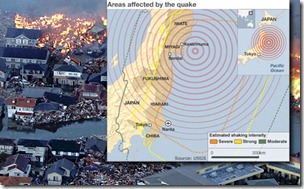
The casualty numbers currently stand at 8000 dead and over 12,000 missing. However, as bad as the situation currently is, it could have been much worse if a quake of this magnitude had hit any country other than Japan.
Japan is one of the most prepared countries in the world for a disaster like this. And here’s why.
Japan probably has the toughest building sanctions in the world and has spent billions of dollars to make its buildings safer. Concrete is still used in a lot of construction so most of the buildings have deep foundations. Many modern techniques are also employed in order to protect the buildings against an earthquake, for instance, base isolation. It involves mounting the building at the ground level on large rubber blocks or sliding bearings, which allows the building to sway rather than act as a rigid structure which is much more prone to collapse. These act as shock absorbers on a car. Japan also enforces tough rules on building gas and water pipeline.
Other than building sanctions, Japan is also using technology and has employed a $ 1 billion early earthquake warning system which was launched in 2007. And this earthquake proved the money was well spent. The system sent out a warning to millions of people 10 seconds before the earthquake struck. People who were further away, like those in Tokyo got a full 1 minute heads up. The warnings also go out to railway operators who slow down; to crane operators who move heavy machinery and building material away from people; and gas and electricity companies who immediately halt their activities.
Japanese children are told what to do in an earthquake from a very early age. Every year, routine drills are carried out. In the last annual drill, over 670,000 people participated.
The need for these measures and the effort Japan exerts is because Japan accounts for 20% of the worlds most powerful earthquakes.
There is no doubt that a lot of lives were saved due to Japans preparation. Now, other countries prone to earthquakes are moving to mimic the Japanese system for disaster management.
There’s a lesson to be learned for us Pakistani’s too. Bring in mind the earthquake of 2005, and the chaos that ensued after it. It is clear we were simply not prepared for it. It’s required that our government take a look at the Japanese model and try to emulate it so that lives can be saved when the next disaster strikes.